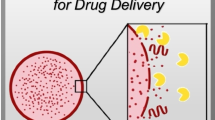Abstract
Purpose. To investigate the effects of the modification of the copolymers poloxamer 407 and poloxamine 908 on the physical and biological properties surface modified polystyrene nanospheres.
Methods. A method to modify poloxamer 407 and poloxamine 908, introducing a terminal amine group to each PEO chain has been developed. The aminated copolymers can be subsequently radiolabelled with lodinated (I125) Bolton-Hunter reagent. The aminated copolymers were used to surface modify polystyrene nanospheres. The physical and biological properties of the coated nanospheres were studied using particle size, zeta potential, in vitro non-parenchymal cell uptake and in vivo biodistribution experiments.
Results. The presence of protonated amine groups in the modified copolymers significantly affected the physical and biological properties of the resulting nanospheres, although the effects were copolymer specific. The protonated surface amine groups in both copolymers reduced the negative zeta potential of the nanospheres. Acetylation of the copolymer's free amine groups resulted in the production of nanospheres with comparable physical properties to control unmodified copolymer coated nanospheres. In vivo, the protonated amine groups in the copolymers increased the removal of the nanospheres by the liver and spleen, although these effects were more pronounced with the modified poloxamer 407 coated nanospheres. Acetylation of the amine groups improved the blood circulation time of the nanospheres providing modified poloxamine 908 coated nanospheres with comparable biological properties to control poloxamine 908 coated nanospheres. Similarly, modified poloxamer 407 coated nanospheres had only slightly reduced circulation times in comparison to control nanospheres.
Conclusions. The experiments have demonstrated the importance of copolymer structure on the biological properties of surface modified nanospheres. Modified copolymers, which possess comparable properties to their unmodified forms, could be used in nanosphere systems where antibody fragments can be attached to the copolymers, thereby producing nanospheres which target to specific body sites.
Similar content being viewed by others
REFERENCES
M. E. Norman, P. Williams, and L. Illum. J. Biomed. Mat. Res. 27:861–866 (1993).
S. S. Davis, L. Illum, S. M. Moghimi, M. C. Davies, C. J. H. Porter, I. S. Muir, A. Brindley, N. M. Christy, M. E. Norman, P. Williams, and S. E. Dunn. J. of Control. Rel. 24:157–163 (1993).
S. E. Dunn, M. C. Garnett, S. S. Davis, M. C. Davies, and L. Illum. J. Control. Rel. 44:65–76 (1997).
N. Watrous-Peltier, J. Uhl, V. Steel, L. Brophy, and E. Merisko-Lieversidge. Pharm. Res. 9:1177–1183 (1992).
J. Vandorpe J., E. Schacht E., S. E. Dunn S. E., A. Hawley A., S. Stolnik S., S. S. Davis, M. C. Garnett, M. C. Davies, and L. Illum. Biomaterials 18:1147–1152 (1997).
J. C. Neal, E. Schacht, S. Stolnik, M. C. Garnett, S. S. Davis, and L. Illum. In vitro displacement of adsorbed radiolabelled poloxamer and poloxamine copolymers from model and biodegradable nanospheres by rat serum. Submitted for publication (1997).
S. Zalipsky, E. Brandeis, M. S. Newman, and M. C. Woodle. FEBS letters 353:71–74 (1994).
Y. Huh, W. Donaldson, and F. J. Johnston. Rad. Res. 60:42–53 (1974).
S. E. Dunn, A. Brindley, S. S. Davis, M. C. Davies, and L. Illum. Pharm. Res. 11:1016–1022 (1994).
H. M. Patel, S. N. Tuzel, and B. E. Ryman. Biochim. Biophys. Acta. 761:142–151 (1983).
L. Illum, L. O. Jacobsen, R. H. Muller, E. Mak, and S. S. Davis. Biomaterials 8:113–117 (1987).
I. S. Muir, S. M. Moghimi, L. Illum, S. S. Davis, and M. C. Davies. Biochem. Soc. Trans. 19:329S (1991).
C. J. H. Porter. Targeting of colliodal carriers to the bone marrow. PhD thesis. University of Nottingham (1992).
I. Ahmad, M. Longenecker, J. Samuel, and T. M. Allen. Cancer Res. 53:1484–1488 (1993).
J. S. Tan, D. E. Butterfield, C. L. Voycheck, K. D. Caldwell, and J. T. Li. Biomaterials 14:823–833 (1993).
G. Blume, G. Ceve, M. D. J. A. Crommelin, I. A. J. M. Bakker-Woudenberg, C. Kluft, and G. Storm. Biochim. Biophys. Acta. 1149:180–184 (1993).
T. M. Allen, A. K. Agrawal, I. Ahmad, C. B. Hansen, and S. Zalipsky. J. Liposome Res. 4:1–25 (1994).
D. J. Wilkins and P. A. Myers. Br. J. Exp. Path. 47:568–576 (1966).
R. L. Juliano and D. Stamp. Biochim. Biophys. Res. Commun. 63:651–658 (1975).
Y. Tabata and Y. Ikada. Biomaterials 9:356–362 (1988).
Y. Tabata and Y. Ikada. J. Coll. Inter. Sci. 127:132–140 (1989).
Y. S. Park, K. Maruyama, and L. Huang. Biochim. Biophys. Acta 1108:257–260 (1992).
Author information
Authors and Affiliations
Rights and permissions
About this article
Cite this article
Neal, J.C., Stolnik, S., Garnett, M.C. et al. Modification of the Copolymers Poloxamer 407 and Poloxamine 908 can Affect the Physical and Biological Properties of Surface Modified Nanospheres. Pharm Res 15, 318–324 (1998). https://doi.org/10.1023/A:1011987206722
Issue Date:
DOI: https://doi.org/10.1023/A:1011987206722




